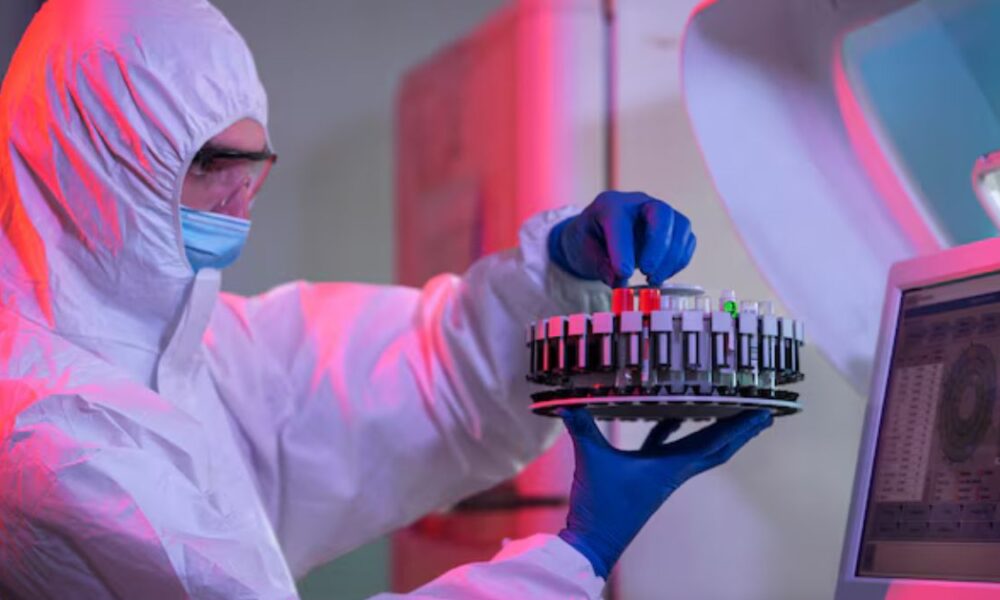Introduction to ADN-237
The world of materials science is on the brink of a revolution, and at its forefront lies ADN-237. This innovative compound represents an exciting leap forward in the realm of advanced materials. As industries seek to innovate and improve efficiency, ADN-237 emerges as a key player with its unique properties and diverse applications.
Imagine a material that enhances strength while reducing weight or one that can withstand extreme conditions without compromising performance. That’s the promise we see with ADN-237. From aerospace to healthcare, this remarkable substance holds potential that could reshape entire sectors.
Join us as we explore what makes ADN-237 so extraordinary, how it functions within various industries, and where it might take us in the future. The journey into advanced materials has just begun!
What are Advanced Materials?
Advanced materials are substances engineered to exhibit superior properties compared to conventional materials. These innovations often lead to enhanced performance, durability, and efficiency across various applications.
They can encompass metals, ceramics, polymers, and composites. Each type possesses unique characteristics tailored for specific uses in industries ranging from aerospace to electronics.
The development of advanced materials is driven by the pursuit of sustainability and functionality. Researchers focus on creating lighter yet stronger options that reduce energy consumption while improving overall effectiveness.
Furthermore, these materials often incorporate smart technologies. This allows them to respond dynamically to environmental changes or stimuli—transforming how products function in everyday life.
As we explore the realm of advanced materials like ADN 237, it’s clear they play a pivotal role in shaping our future technology landscape.
Properties and Applications of ADN-237
ADN-237 is a remarkable advanced material that showcases exceptional properties. Its lightweight structure combined with high strength makes it ideal for various demanding applications.
This material exhibits excellent thermal stability, making it suitable for environments with extreme temperatures. Additionally, ADN 237 has impressive corrosion resistance, ensuring longevity in harsh conditions.
In the aerospace industry, ADN-237 can be utilized to create components that enhance fuel efficiency and reduce overall weight. The automotive sector benefits from its ability to improve performance while maintaining safety standards.
Healthcare applications are also on the rise. ADN 237’s biocompatibility opens doors for innovative medical devices and implants. Its unique attributes allow for the development of smarter technologies across multiple fields.
With ongoing research and experimentation, the potential uses of ADN-237 continue to expand beyond current limitations.
Advantages of using ADN-237
ADN-237 offers remarkable advantages that set it apart in the realm of advanced materials. Its lightweight nature significantly reduces energy consumption without compromising structural integrity.
Durability is another key benefit. This material exhibits resistance to wear, corrosion, and extreme temperatures, making it ideal for demanding environments. Industries can rely on ADN 237 for long-lasting performance.
Another advantage lies in its versatility. ADN-237 adapts well to various applications across different sectors, from aerospace to healthcare. Customization options further enhance its appeal, allowing manufacturers to fine-tune properties for specific uses.
Moreover, the eco-friendliness of ADN 237 cannot be overlooked. It often employs sustainable production methods and contributes to reducing carbon footprints throughout its lifecycle.
These attributes position ADN-237 as a game-changer in modern engineering solutions, paving the way for innovative designs and improved efficiencies across multiple industries.
Potential Impact on Various Industries
ADN-237 is poised to revolutionize several key industries. Its unique properties make it an ideal candidate for aerospace applications, where weight reduction and strength are critical. Aircraft components made from ADN 237 can enhance fuel efficiency while ensuring safety.
In the automotive sector, ADN 237 could transform vehicle design. Lighter materials lead to improved performance and lower emissions, aligning perfectly with global sustainability goals.
Healthcare also stands to benefit significantly from this advanced material. Potential uses include durable prosthetics and innovative medical devices that require biocompatibility and resilience.
The construction industry isn’t left behind either; ADN-237 offers a pathway toward more sustainable building practices through lightweight yet strong structural elements that withstand harsh conditions.
As these industries explore ADN 237’s capabilities, we may witness significant shifts in how products are designed, manufactured, and utilized across various sectors.
Challenges and Limitations of ADN-237
Despite its promising advantages, ADN-237 faces several challenges that could hinder its widespread adoption. One significant obstacle is the cost associated with production and processing. High-quality advanced materials often come with a hefty price tag, which can deter potential users.
Another limitation lies in compatibility issues. Not all existing systems and processes can seamlessly integrate ADN-237 without modifications or special considerations. This creates additional hurdles for industries looking to implement this innovative material.
Moreover, there are concerns regarding long-term stability and durability under varying environmental conditions. Research is still needed to fully understand how ADN 237 performs over time when exposed to extreme temperatures or corrosive substances.
Regulatory frameworks surrounding new materials can be complex and slow-moving. Navigating these regulations adds another layer of difficulty for companies eager to harness the benefits of ADN-237 while ensuring safety and compliance.
Future Outlook and Possibilities
The future of ADN-237 is brimming with possibilities. Researchers are continuously exploring innovative ways to harness this advanced material’s unique properties.
Emerging technologies could see ADN 237 integrated into various sectors, enhancing performance and efficiency. Imagine lightweight structures that do not compromise on strength, revolutionizing the aerospace industry.
In healthcare, the potential for biocompatible applications is vast. From implants to drug delivery systems, ADN-237 could enable breakthroughs in patient care.
Sustainability also plays a role as industries seek greener alternatives. The versatility of ADN 237 may lead to environmentally friendly production processes and recyclable materials.
Collaboration among scientists and engineers will be crucial in unlocking these potentials. As more discoveries unfold, we can expect ADN-237 to redefine standards across multiple domains, paving the way for technological advancements previously thought unattainable.
What is ADN-237?
ADN-237 is an innovative advanced material gaining attention across various sectors. Developed through cutting-edge research, it combines unique properties that enhance performance and durability.
This material is characterized by its lightweight nature while maintaining exceptional strength. Its molecular structure allows for flexibility, making it suitable for numerous applications where traditional materials may fall short.
ADN-237’s versatility sets it apart from conventional options. Engineers and designers are increasingly exploring its potential in industries ranging from aerospace to healthcare. This adaptability opens doors to new possibilities in product design and manufacturing techniques.
The synthesis of ADN 237 involves sophisticated processes that result in a highly engineered compound. As research continues, the full extent of its capabilities remains an exciting prospect on the horizon.
Advancements and Breakthroughs in ADN-237
Recent advancements in ADN-237 have showcased its unique potential as a transformative material. Researchers have made significant strides in enhancing its mechanical properties, leading to greater strength and durability.
Innovations in processing techniques allow for improved scalability. This means that industries can manufacture ADN-237 components more efficiently than ever before.
Moreover, the integration of nanotechnology into ADN 237 has opened doors to new applications. Tiny enhancements at the molecular level provide exceptional thermal stability and corrosion resistance.
These breakthroughs not only expand the scope of what’s possible with advanced materials but also position ADN 237 as a key player in cutting-edge industries like aerospace and healthcare. Each advancement pushes boundaries further, making it an exciting area for ongoing research and application exploration.
Potential Applications of ADN-237
ADN-237 is poised to revolutionize various sectors with its unique properties. In aerospace, its lightweight and high-strength characteristics enhance fuel efficiency while ensuring safety in aircraft design.
The automotive industry stands to benefit significantly from ADN 237 as well. Its durability can improve vehicle performance and longevity, reducing maintenance costs for manufacturers and consumers alike.
Healthcare applications are also on the horizon. With biocompatibility at its core, ADN-237 could lead to advancements in medical devices, implants, and even drug delivery systems.
Additionally, electronics may experience a transformation through this advanced material. Its thermal stability makes it suitable for components that require reliable performance under extreme conditions.
Each potential application showcases how ADN-237 can push boundaries across industries. As research continues, more innovative uses will likely emerge.
Impact on Industries such as Aerospace, Automotive, and Healthcare
ADN-237 is set to revolutionize multiple industries, particularly aerospace. Its lightweight properties and high strength make it ideal for aircraft components. Reduced weight leads to improved fuel efficiency, making air travel more sustainable.
In the automotive sector, ADN 237 can enhance vehicle performance while also contributing to safety measures. Stronger materials allow manufacturers to design vehicles that can withstand greater stress without adding unnecessary bulk.
Healthcare applications are equally promising. With its biocompatibility and durability, ADN-237 is paving the way for advanced medical devices and implants. These innovations could lead to longer-lasting solutions that improve patient outcomes.
Across these sectors, the integration of ADN 237 fosters innovation and pushes boundaries in research and development. As companies adopt this material, we may witness significant advancements changing how products are designed and utilized in everyday life.
Challenges and Limitations of ADN-237
Despite the promising potential of ADN-237, it faces several challenges that hinder its widespread adoption. One significant issue is the high cost associated with production and processing. Many manufacturers find it difficult to justify the investment needed for large-scale implementation.
Another challenge lies in its compatibility with existing materials. Integrating ADN-237 into current manufacturing processes can require extensive modifications. This complicates supply chains and increases time-to-market for new products.
Additionally, there are performance-related concerns under extreme conditions. While ADN 237 boasts impressive properties, its durability in harsh environments remains a topic of ongoing research.
Regulatory hurdles also pose obstacles. The approval process for advanced materials often involves rigorous testing and compliance checks, which can slow down innovation and deployment across various sectors.
The Future of Advanced Materials and Their Role in Technological Advancement
The landscape of advanced materials is shifting rapidly, with ADN-237 leading the charge. This innovative material combines strength and flexibility, opening new doors in various sectors.
As industries evolve, so too do their demands. ADN 237’s unique properties make it an ideal candidate for lightweight structures that can withstand extreme conditions. Imagine aircraft designed with this material—lighter, stronger, and more fuel-efficient.
Healthcare also stands to benefit significantly from advancements in ADN-237. Biocompatibility opens avenues for medical devices that improve patient outcomes while reducing recovery times.
The push towards sustainability features prominently in discussions around advanced materials. With its potential for recycling and low environmental impact during production, ADN-237 aligns perfectly with global initiatives aimed at reducing ecological footprints.
Innovation thrives on collaboration across disciplines. As researchers continue to explore the possibilities of ADN-237, we may see technologies emerging that transform everyday life in ways we have yet to imagine.
Conclusion
The future of ADN-237 is promising and set to reshape industries. As advanced materials continue to evolve, their applications will expand further into various fields. The unique properties of ADN-237 offer solutions that can enhance product performance while reducing weight and costs.
Industries such as aerospace, automotive, and healthcare stand to gain significantly from these advancements. With the ability to improve efficiency and sustainability, ADN 237 could lead the charge in innovation across multiple sectors.
However, challenges remain. Addressing production scalability and material durability is essential for widespread adoption. Collaborative efforts between researchers, manufacturers, and policymakers will be crucial in overcoming these hurdles.
As we look ahead, it’s clear that ADN-237 holds a pivotal role in technological advancement. Its potential impacts are vast—from enhancing fuel efficiency in aircraft to developing new medical devices that improve patient outcomes.
The journey of advanced materials like ADN-237 has just begun; its implications may redefine what’s possible in engineering design and manufacturing for years to come.

















